Non-odontogenic tumors
Master the INBDE with Dental Panda: Your go-to resource for expert practice exams and tailored study resources!
BENIGN NON-ODONTOGENIC TUMORS
OSSIFYING FIBROMA
Ossifying Fibromas are benign but potentially aggressive fibro-osseous neoplasms that often behave like benign bone neoplasms. They consist of fibrous tissue that contains varying amounts of calcified tissue resembling bone and/or cementum. Ossifying fibromas can be divided into several variants; the conventional form (cemento-ossifying fibroma), and two juvenile forms (juvenile trabecular ossifying fibroma, and juvenile psammomatoid ossifying fibroma) which are more common in younger patients. The common clinical presentation includes:
- Well-defined unicystic, multicystic or mixed-density lesion with smooth borders.
- Internal structure may be a mixture of radiolucent and radiopaque tissue.
- Margins may be sclerotic.
- Can resorb roots, displace teeth, and cause bony expansion producing deformity, malocclusion, dysfunction.
- Cortical perforation is generally not seen.
- May displace inferior alveolar nerve canal.
Diagnosis is based on the lesion history, clinical presentation and microscopic findings, which may include:
- Fibroblast-like cells within a fibrovascular stroma.
- Islands of trabecular bone/woven bone.
- May contain cementum droplets.
Your differential diagnosis should include:
- Odontogenic cyst.
- Giant cell lesion.
- Odontogenic tumor.
Treatment options include:
- Conservative excision.
- Bony curettage (enucleation).


OSTEOMA
Osteoma is a benign slow-advancing bone forming tumor that consists primarily of well-differentiated mature compact or cancellous bone. Maxillary and mandibular tori are not considered osteomas. Osteomas are linked to Gardner’s syndrome. The common clinical presentation includes:
- Round well-circumscribed homogeneous radiodensity.
- May be positioned subperiosteal or medullary.
- Asymptomatic and usually discovered incidentally.
- May cause painless swelling and facial asymmetry.
- Symptoms secondary to nasal/paranasal obstruction include sinusitis, nasal discharge and mucocele formation.
- Symptoms secondary to orbital involvement include exophthalmos, proptosis, ptosis, and diplopia.
Diagnosis is based on the lesion history, clinical presentation and microscopic findings, which usually includes mature bone formation that blends imperceptibly with the underlying normal bone. Your differential diagnosis should include:
- Tori or exostosis.
- Ossifying fibroma.
- Osteoblastoma.
- Focal sclerosing osteitis.
Treatment may not be necessary.




PERIPHERAL OSSIFYING FIBROMA
Peripheral Ossifying Fibroma is an inflammatory hyperplastic lesion of gingiva often linked to chronic irritation. Generally understood to be non-neoplastic, it is a reactive lesion of connective tissue and is not the soft-tissue equivalent of central ossifying fibroma. Confusingly, it has been referred to as peripheral cementifying fibroma, calcifying or ossifying fibroid epulis, mineralizing ossifying pyogenic granuloma, peripheral fibroma with calcifications and calcifying fibroblastic granuloma. The common clinical presentation includes:
- Early lesion – irregular red painless mass on gingiva/alveolar mucosa that may bleed easily.
- Mature lesion – smooth pink surface that may be ulcerated.
- Pedunculated or sessile base with nodular appearance.
- Slow growing with possible tooth displacement.
Diagnosis is based on the lesion history, clinical presentation and microscopic findings, which may include:
- Poorly circumscribed fibrous proliferations of fibroblastic spindle cells.
- Synthesis of bone (mature or immature), cementum or calcifications.
- Usually ulcerated with granulation tissue base.
Your differential diagnosis should include:
- Other reactive lesions (pyogenic granuloma, peripheral giant cell granuloma, and peripheral odontogenic fibroma).
- Peripheral odontogenic tumor.
- Osteosarcoma.
Treatment usually involves surgical excision, including underlying periosteum or associated periodontal ligament.


MALIGNANT NON-ODONTOGENIC TUMORS
EWING'S SARCOMA
Ewing’s Sarcoma and Ewing-like sarcomas are highly aggressive malignant mesenchymal neoplasms usually seen in the metaphysis of long bones during the first and second decades of life. The common clinical presentation includes:
- A large, multilobulated mass with extensive necrosis and/or hemorrhage.
- Diffuse, irregular, lytic bone lesion with “moth-eaten” radiographic appearance.
- A periosteal reaction forming “sun-ray” spicules or the “onion- skin” pattern.
- Can cause pain, paresthesia and swelling (cortical expansion).
- May cause fevers, anemia, leukocytosis, and increased sedimentation rate.
Diagnosis is based on the lesion history, clinical presentation and microscopic findings, which may include:
- Monomorphic round cell populations.
- Very high mitotic activity.
- Presence of abundant necrosis.
Your differential diagnosis should include:
- Osteosarcoma.
- Lymphoma.
- Rhabdomyosarcoma.
Treatment options include:
- Radiotherapy.
- Chemotherapy.
- Surgery.
- Stem cell transplantation.
- Targeted immunotherapy.
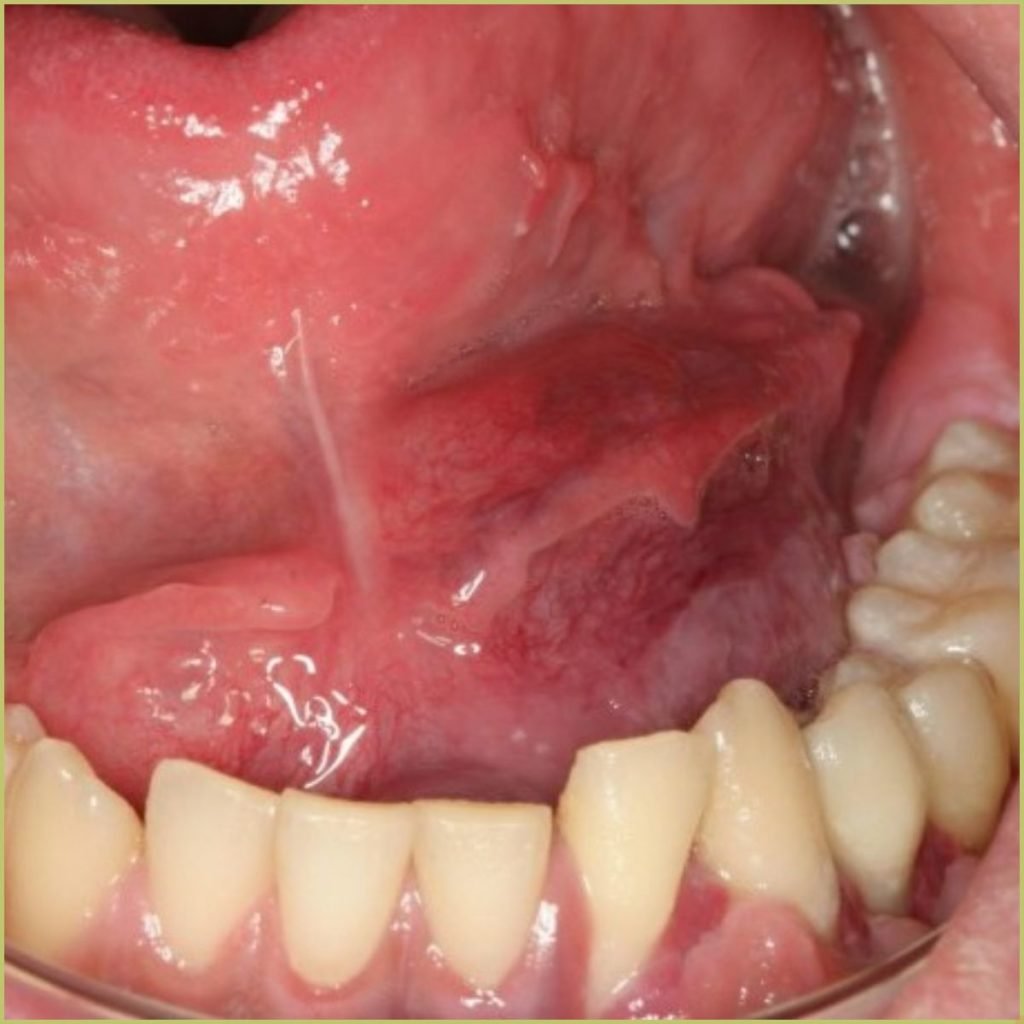

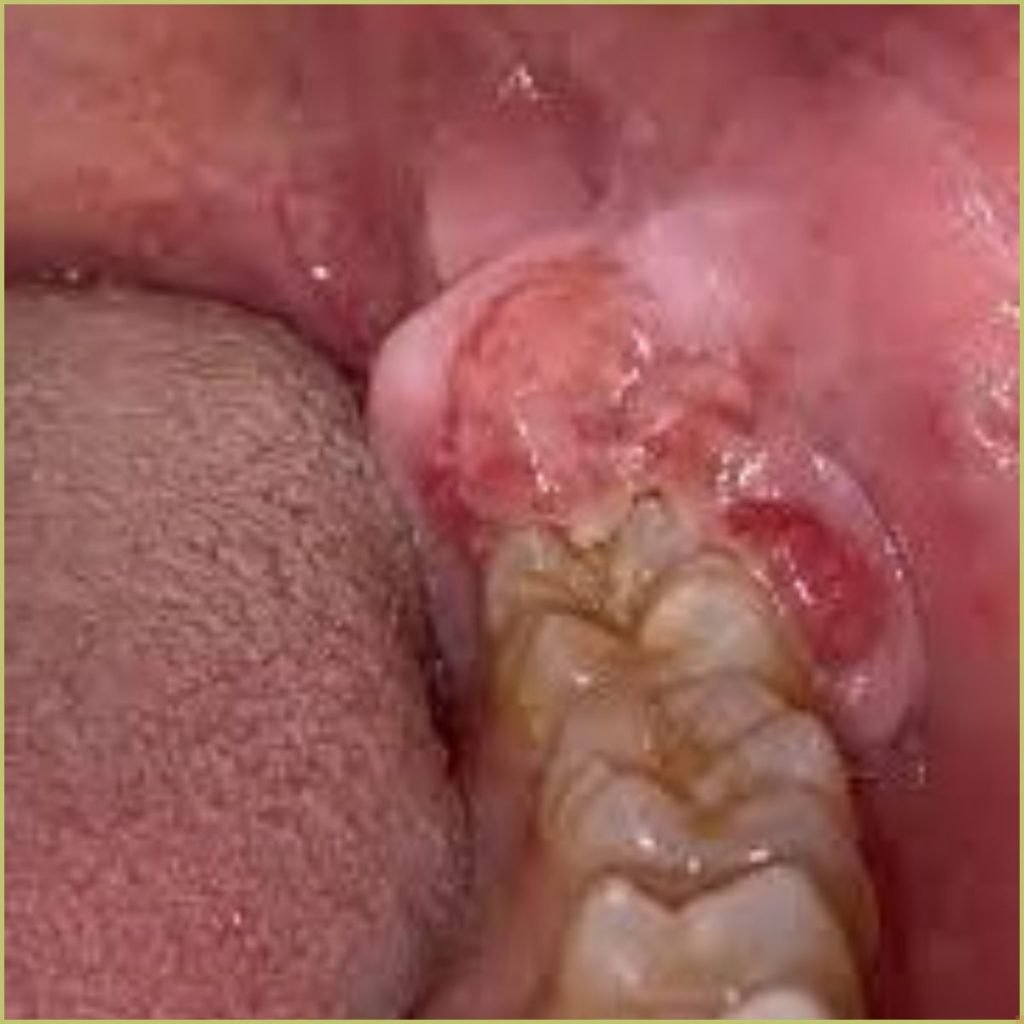
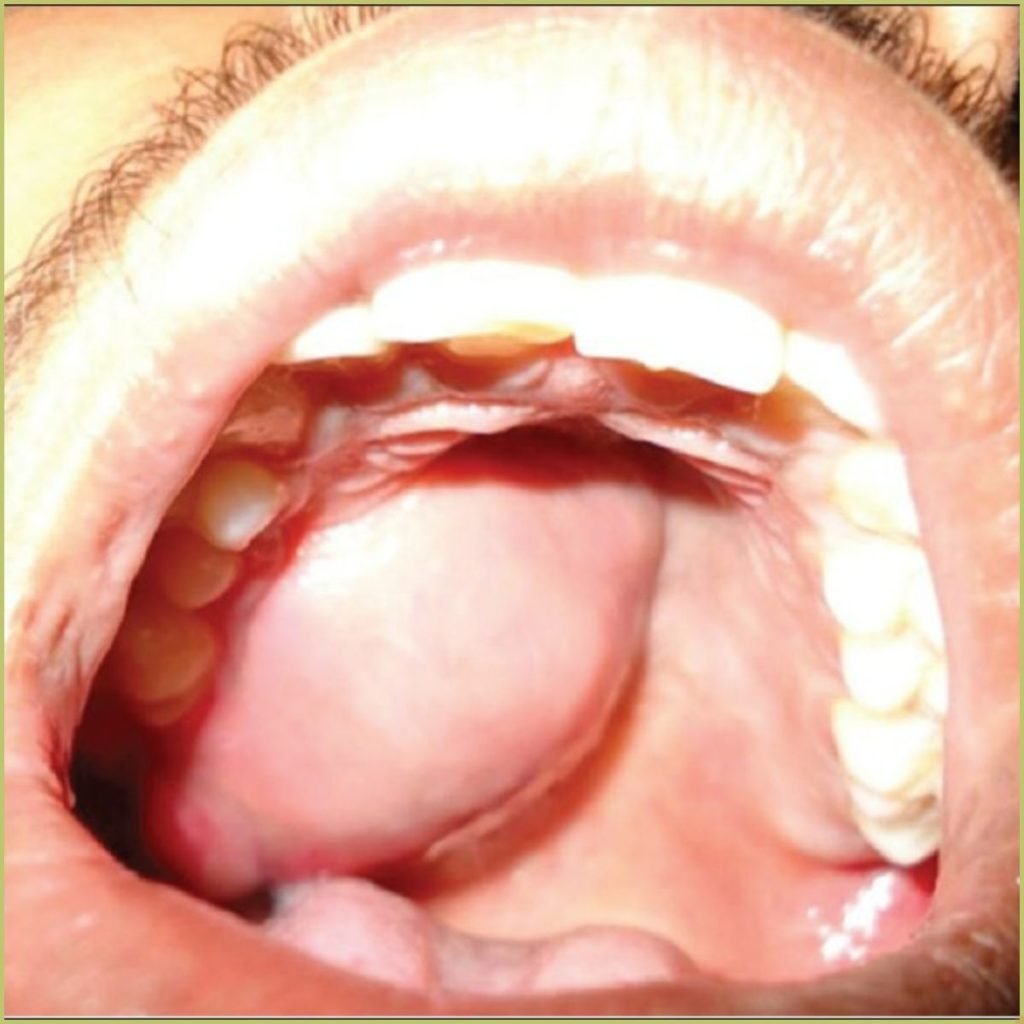
OSTEOSARCOMA
Osteosarcoma is a very rare aggressive malignant neoplasm that arises from transformed mesenchymal cells and is commonly seen in the metaphysis of the long bones near the growth plates. It may be associated with pre-existing disease like Paget’s disease or Fibrous dysplasia. The common clinical presentation includes:
- Early lesion – displacement of teeth, root resorption, widened PDL space.
- Mature lesion – lytic “moth-eaten” destruction that includes cortical destruction and extension into soft tissues.
- Erosion of mandibular canal.
- “Sunburst effect” (radiating radiopaque spicules).
- May cause pain, paresthesia, trismus, and nasal/paranasal obstruction.
Diagnosis is based on the lesion history, clinical presentation and microscopic findings, which may include:
- Osteoblastic differentiation and malignant osteoid production.
- Pleomorphic (anaplastic) tumor cells with atypical mitosis.
- May contain multinucleated osteoclast-like giant cells.
Your differential diagnosis should include:
- Fibro-osseous lesion.
- Osteomyelitis.
- Osteoradionecrosis.
- Metastatic tumor.
- Other sarcoma.
Treatment is often aggressive and may include:
- Radical ablative surgery.
- Chemotherapy.
- Radiotherapy.
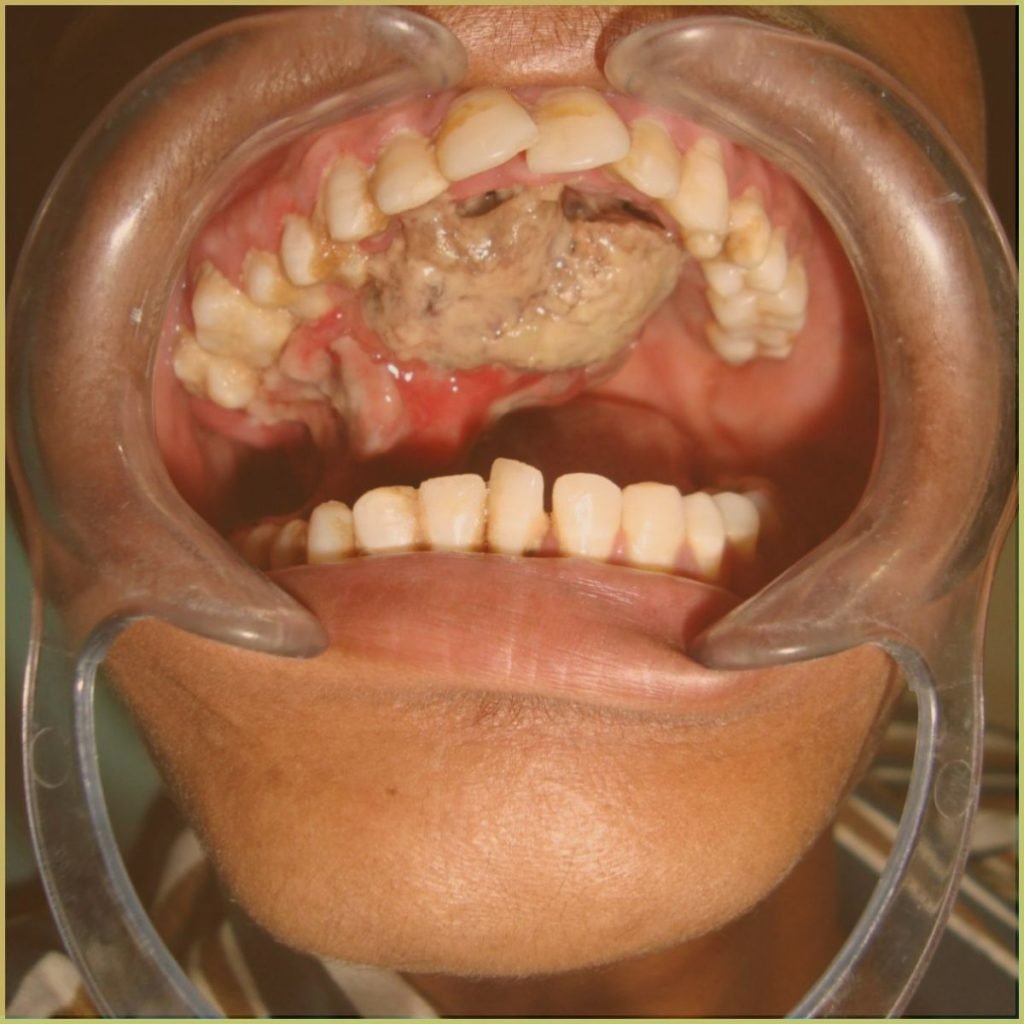

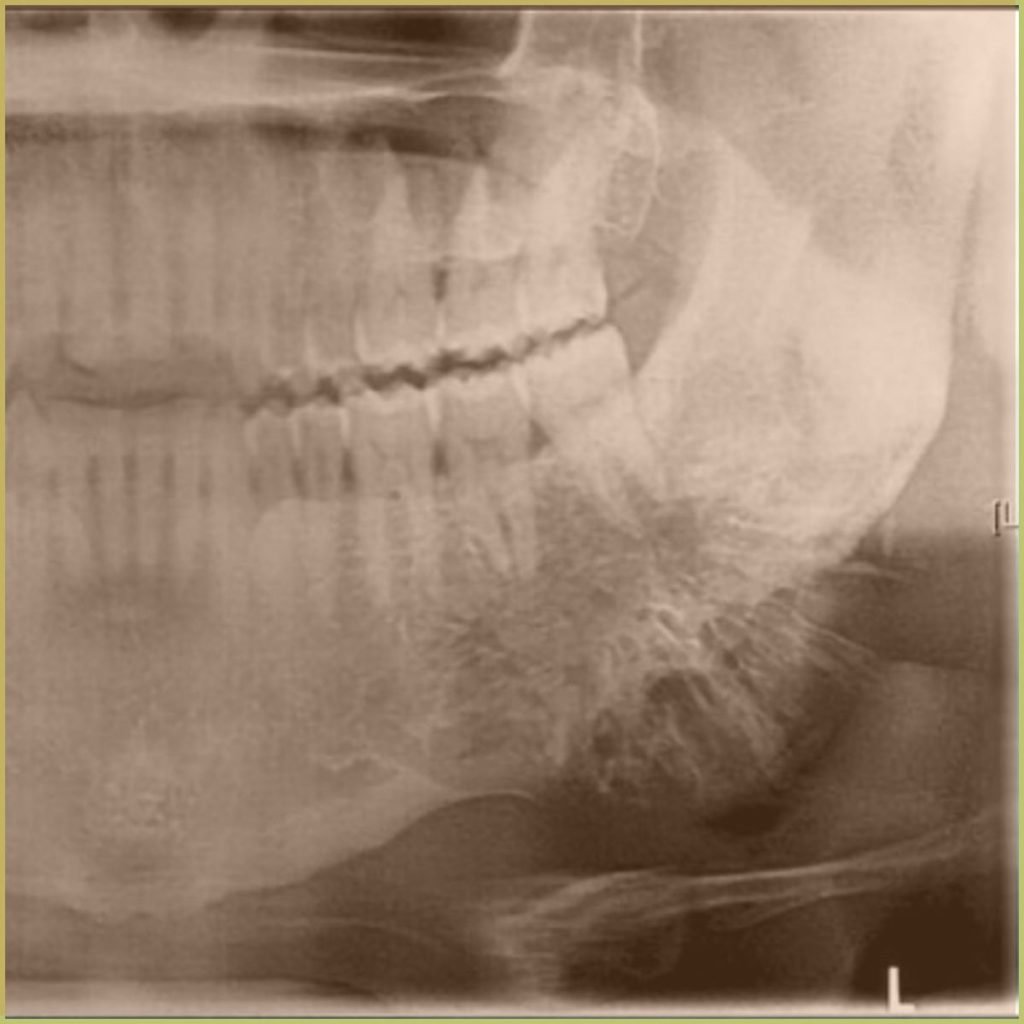

TUMOR STAGING
Tumor staging systems like the Tumor-node-metastasis (TNM), Lugano system or FIGO system are used to estimate disease severity and treatment outcomes. Grading describes the histological cellular appearance and is commonly determined during histological workup of pre-therapeutic biopsies. Stage refers to tumor size and spread. TNM is the most commonly used. Grading is broken down by:
- T – primary tumor – information about a tumor’s size and location at the time of diagnosis.
- TX – Tumor cannot be assessed.
- T0 – no evidence of primary tumor.
- Tis – carcinoma-in-situ. The tumor is still within the confines of the normal tissue.
- T1 – <2cm.
- T2 – >2cm.
- T3 – >4cm.
- T4 – Tumor has invaded deep structures (antrum, pterygoid muscles, tongue etc.)
- N – nodes – whether a tumor has spread to nearby lymph nodes.
- NX – lymph nodes cannot be assessed.
- N0 – no nodal involvement.
- N1 – single ipsilateral node <3 cm.
- N2a – single ipsilateral node 3-6cm.
- N2b – multiple ipsilateral nodes 3-6cm.
- N2c – bilateral nodes 3-6cm.
- N3 – nodes >6cm.
- M – metastasis – tumor has spread beyond nearby lymph nodes.
- MX – metastases cannot be assessed.
- M0 – no metastases.
- M1 – distant metastasis.
The combined grading is used to determine the stage:
- Stage 0 – Tumor confined to normal area (Tis N0 M0).
- Stage I – Smaller tumors (T1-T2) that haven’t spread (N0 M0).
- Stage II – Larger tumors (T2-T4) that haven’t spread (N0 M0).
- Stage III – Large tumors (T2-T4) that have spread to nearby lymph nodes (N1-N3), but not to other areas of your body (M0).
- Stage IV – Metastatic cancer (T1-T4, N1-N3 and M1).
